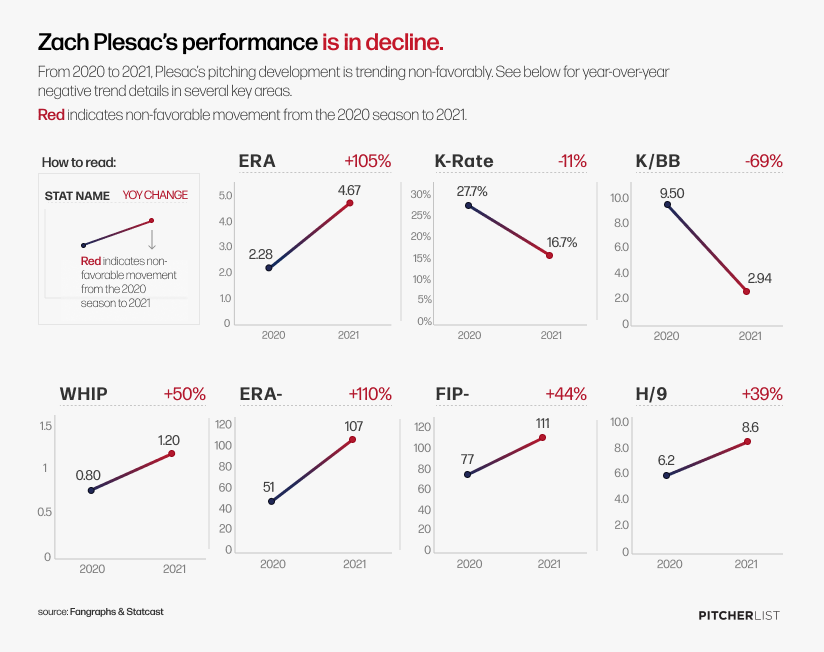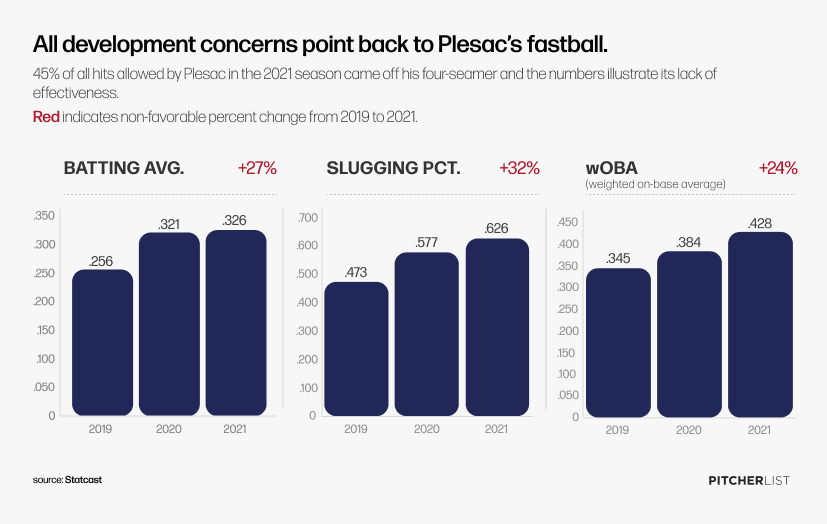Cleveland Guardians starter Zach Plesac entered 2021 with some Cy Young buzz and left it with year-over-year spikes in multiple key metrics. One reason for his struggles has been in plain sight for a while. The other appeared to come through a tweak in his windup.
Plesac’s fastball – his weakest and most frequently used pitch – was hit harder than ever in 2021, and an adjusted delivery may have inadvertently weakened the changeup he uses to counter that. The results from this unfortunate combo should cause hesitation for anyone betting on him to replicate the sparkling numbers he displayed in 2020.
At first glance, the performance we saw from him in 2021 merits a stronger explanation. Was his arm not stretched out enough after last year’s 60-game campaign? Did he struggle to recover from the broken thumb he suffered in May?
All in all, Plesac’s numbers jumped so significantly year over year that it forces you to believe it had more to do with just a couple pitches from his arsenal.

When attempting to solve this mystery, it’s hard to ignore Plesac’s four-seamer.
His fastball has never been hit more frequently (.326 opponent batting average), for more bases (.626 opponent slugging percentage), or for hits with more offensive value (.428 opponent weighted on-base average) than it was this past season. Of the 137 hits he allowed in 2021, 45% came off his four-seamer, 71% of which were hit hard.
Opposing hitters didn’t just connect with Plesac’s fastball last year. They tattooed it.
But this isn’t just a one-year occurrence. The numbers Plesac has allowed with his four-seamer have been quite gaudy ever since his 2019 debut.

It’s a pitch that boasts a relatively underwhelming profile. Statcast ranked Plesac’s fastball in the 41st percentile in velocity and in the 11th percentile for spin rate. Its vertical and horizontal movement is decent, but its whiff rate has hovered at a low 15%-17% range during his three years in the bigs.
Still, it didn’t cause him much harm in 2020. By pairing his four-seamer with two notably better pitches – sliders against righties and changeups against lefties – Plesac finished the year with the ninth-lowest ERA among pitchers with at least 50 innings of work.
He took a similar mound approach in 2021, once again generating strong results with his slider. With his changeup, though, we see a different story.
Plesac’s changeup whiff rate fell 14.5% from 2020, while its hard-hit rate nearly doubled. Opposing batters have never swung at nor made contact against this offering as frequently as they did in 2021. With an xwOBA of .321, Plesac’s changeup wasn’t necessarily getting pummeled. Hitters just didn’t seem as fooled by it as they were in the previous season.
A reason for this may be found in an adjustment Plesac made with his delivery.
As noted by Michael Ajeto in April, Plesac’s leg kick was less drastic in 2021. This delivery tweak shifted his release point, a move Ajeto concluded negatively impacted Plesac’s ability to be deceptive with his pitches.
It also might have given opposing hitters a sneak peek at the upcoming offering.
In 2020, when extending his leg out towards third during his windup, Plesac wasn’t removing the ball from his glove until it was out of the hitter’s sight. By taking a more direct step toward home last year, he started revealing the ball earlier.
When comparing the two approaches, it seems the latter provides a better opportunity for batters to detect what grip he was using before the pitch was thrown.
Though this is hardly on par with pitch-tipping, it could help explain why hitters were significantly less thrown off by Plesac’s changeup than they were in the previous season. Or why the pitch’s putaway percentage dropped from 26.4% to 11.9% in 2021.
This loss in changeup effectiveness did him no favors, especially when paired with a four-seamer that batters already have no trouble connecting with.
Plesac’s slider still remained encouragingly effective despite the adjusted windup, though a 100-point jump in its xwOBA could be worth monitoring. Likewise, strong results generated from his curve last year should have him boosting that pitch’s usage rate.
But if he struggles to keep hitters guessing with his counter-offerings, it’ll be even harder for him to get by with what many of them treat as a batting practice fastball.
Photo by Carrie Giordano/Icon Sportswire | Adapted by Justin Redler (@reldernitsuj on Twitter)
